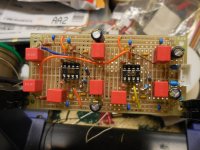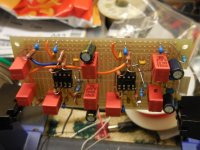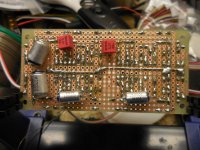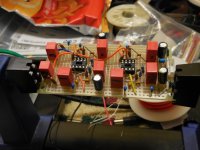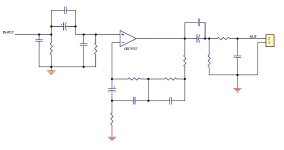We're in an op-amp thread, but it would be incomplete to forget the vacuum valve alternative, still popular in diyAudio land, especially with old Fudds like me. These can remove any possible issues with overhead, and can be quiet enough for ordinary use, but introduce issues of not being an op-amp, like power supply and signal common interactions, builder safety, and such. A great virtue is that everything is big enough to see and manipulate with shakier hands. Don't scoff - y'all will get there too someday.
All good fortune,
Chris
All good fortune,
Chris
That's what I've been telling you carlmart. Yes, you get a list of available op amps they will mount, clean, test and ship anywhere so... for a carrier + OPA1656 + labor + cleaning and testing + misc handling + onesy-twosy profit..... I thought $13 was a bargain - before shipping of course. Not sure that can be beat.I was already aware of what Cimarron was offering, and looking for more affordable pricing somewhere else, if available.
The DIP adapters they sell, which would be necessary to try and compare different dual SOIC types, but they do offer pre-assembled versions with different opamps.
Of course you do Marcel so ready or not it's almost here. No laughing. I know, I know... it's ugly and primitive and many will eschew the power and ground routing but hey, I grew up with tube gear and point-to-point wiring and through-the-air here to there and Gnd is chassis metal right? and if it's in the way, jumper over and when it doubt tack it down, etc. So here it is, my version of the Marcel Marvel as of today.I still think my single-stage circuit is the most suitable, by the way.
Attachments
In other news - I was browsing for "OPA627" as in just threw my line in the water and up came an ebay ad by a USA fella who had loaded all channels of his sound/mixing board way back when with the OPA627 and now didn't need the sound/mixing board so was selling off all of the DIP8 OPA627AP (qty roughly 38) for $39ea. Well I bit on qty 2 b/c he seemed legit. After I received them I checked his ad and at that time he was offering the last ones for $59ea!
Like where? What's the problem with USA and Brazil? What's the problem with $13? Explain please.Any other supplier you can suggest, perhaps not in the USA?
I am with you Chris. I've owned and maintained many legacy (and not so legacy) tube driven pres and amps. I belong to a forum created by necessity for the demise of a 90s SoCal company called Solo Electronics aka Golden Tube Audio (GTA). I'm a grey-beard there for mostly specifically the Model SE-40 - a 2-chan Stereo, 40W/chan pure Class A amplifier strapable to 80W mono. All for now.We're in an op-amp thread, but it would be incomplete to forget the vacuum valve alternative, still popular in diyAudio land, especially with old Fudds like me. These can remove any possible issues with overhead, and can be quiet enough for ordinary use, but introduce issues of not being an op-amp, like power supply and signal common interactions, builder safety, and such. A great virtue is that everything is big enough to see and manipulate with shakier hands. Don't scoff - y'all will get there too someday.
You beat me to building the first MvdG phono preamp, but I do have a chassis ready. Maybe I can be second! And everybody always remembers who came in second. Arf!
All good fortune,
Chris
All good fortune,
Chris
No laughing. I know, I know... it's ugly and primitive and many will eschew the power and ground routing but hey, I grew up with tube gear and point-to-point wiring and through-the-air here to there and Gnd is chassis metal right? and if it's in the way, jumper over and when it doubt tack it down, etc. So here it is, my version of the Marcel Marvel as of today.
I guess you never saw the photo of my preamplifier... Its phono section was published in Electronics World, but I didn't send them a photograph.
JRA, Marcel - better no comment 😀
https://www.pcbway.com/
Even in case of prototypes. If you do not care about oscillations and inductive tracks effects, then of course happily stick with a breadboard 😉.
I measured the comparative noise plots of LT1028, OP27 and OPA627 in this provisional PCB, covered in a shielded case:

I have not used a breadboard for decades 😀.
https://www.pcbway.com/
Even in case of prototypes. If you do not care about oscillations and inductive tracks effects, then of course happily stick with a breadboard 😉.
I measured the comparative noise plots of LT1028, OP27 and OPA627 in this provisional PCB, covered in a shielded case:
I have not used a breadboard for decades 😀.
Just as well; might have been arrested for construction of an explosive device.I didn't send them a photograph.
All good fortune,
Chris
Good bypass juju for the big polyester MKS2 caps and they were on hand in 1%. Not good...? I bought 12x 5% MKS2 to cull eight 1-3% pieces.What are the 10 nF and 27 nF polystyrene capacitors on the bottom for?
I'll be working the enclosure very soon, The external +/- power supply is in-house as are the RCAs 😊 But I might lose a day if I wait for a Hammond EMI box sporting 3mm thick walls made of a polymer embedded with stainless steel bits.You beat me to building the first MvdG phono preamp, but I do have a chassis ready. Maybe I can be second! And everybody always remembers who came in second. Arf!
PCBWAY seems not to ship to Brazil. It's not listed.
But I have an option, very very affordable, that you can use for a pcb for this project. Look at this pcb sold by Aliexpress:
https://www.aliexpress.com/item/100...FtVttasD&utparam-url=scene:search|query_from:
It should involve some working adding the additional passive parts from Marcel's schematic with the HP filter.
I bought another similar kit, with all parts included, but only some will I use. It's a better deal to get the pcb and buy the right precision resistors and capacitors for the RIAA here:
https://www.surplussales.com/
They do not sell ICs, so that you will have to get elsewhere.
For the preamp box & transformer, Aliexpress might have some interesting options. That's how I got my first RIAA kit, that came with a black aluminum box and R-type transformer.
I will open another thread with these projects.
https://www.aliexpress.com/item/100...FtVttasD&utparam-url=scene:search|query_from:
It should involve some working adding the additional passive parts from Marcel's schematic with the HP filter.
I bought another similar kit, with all parts included, but only some will I use. It's a better deal to get the pcb and buy the right precision resistors and capacitors for the RIAA here:
https://www.surplussales.com/
They do not sell ICs, so that you will have to get elsewhere.
For the preamp box & transformer, Aliexpress might have some interesting options. That's how I got my first RIAA kit, that came with a black aluminum box and R-type transformer.
I will open another thread with these projects.
Attachments
I understand the value of the gnd/power planes and copper flooding but just hink of a breadboard in 3D as in x, y and z vs. a flat x-y layout. When flown through the air the distance is shorter with no coupling. An A-to-B jumper is just a pcb trace and/or you can jump over things where otherwise you can't. Many times the here-to-there paths are the same or shorter. Parasitics are nil with a flying lead. Plus it's faster especially when/if you are not ready to commit. So there are "some" advantages. So you like pcbway.com? I imagine that it takes a good bit of prep on your part before handing them a design plan.Even in case of prototypes. If you do not care about oscillations and inductive tracks effects, then of course happily stick with a breadboard 😉.
- Home
- Source & Line
- Analogue Source
- OPA1656 Phono Preamp: Split from OPA1656 thread
